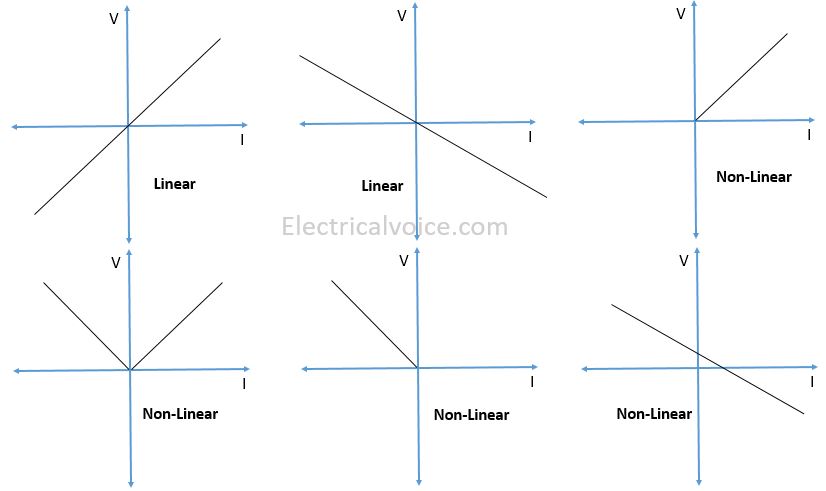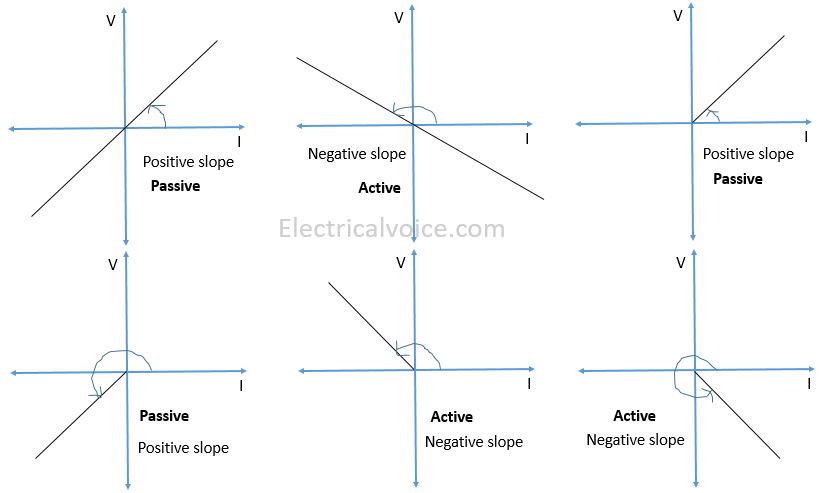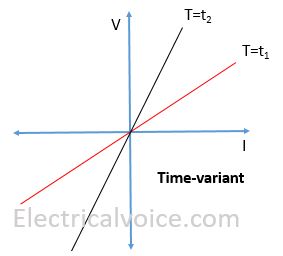In electrical circuits, the classification of circuit elements can be classified as
- Linear and non-linear element
- Active and Passive element
- Unilateral and Bilateral element
- Time-variant and Time invariant element
Linear and non-linear element
An element or a system is said to be linear if it obeys the principles of additive and homogeneity properties. For linear elements, the current is always proportional to the voltage. The V-I characteristics of linear elements is a straight line passing through the origin at all time. Examples: ohmic resistances, conductors etc.

Homogeneity Property:
When I1 is the circuit current for applied voltage E1, then for applied voltage kE1 the circuit current should be kI1. Where k is a constant.
Additive Property:
If I1 is the current for applied voltage E1, I2 is current for Voltage E2 then for applied voltage E1+E2, the current should be I1+I2.
All the elements which are not linear and do not obey the principles of homogeneity and additive properties are called non-linear elements. A nonlinear element doesn’t obey Ohm’s law. Examples: diodes and other semiconducting materials, non-linear resistors etc.
Active and Passive Elements
Active elements are the energy sources which deliver power to the network whereas passive elements are the elements in the network which consume energy.
Power supply elements such as voltage sources and current sources either independent or dependent which deliver power are called active elements. For an active element, the ratio of the voltage to the current (i.e. the slope of the curve) is negative i.e.

The elements which consume energy are called passive elements. These elements either convert energy into another form or store energy in the electric or magnetic field. The elements resistor, inductor and capacitor are the passive elements. For passive elements, the ratio of voltage to current (i.e. the slope of the curve) is positive i.e


Hence it can be concluded that If the slope of V-I characteristic at all points is positive then element has passive behaviour. If at any point on the V-I characteristic, the slope is negative then element has active behaviour.
Unilateral and bilateral elements
The impedance (or resistance) offered by the bilateral elements is same for either direction of the current flow. The volt-ampere (V-I) characteristics of bilateral elements are symmetrical on 1st and 3rd quadrants or on 2nd and 4th quadrants. Examples: Resistors, Inductors and capacitors.
The impedance (or resistance) offered by the unilateral elements differs for currents flowing in either direction. They offer high impedance when a current in one direction and a low impedance when the current direction reverses. Example: Diodes.

The V-I characteristics of unilateral elements are unsymmetrical on 1st and 3rd quadrants or 2nd and 4th quadrants.
Note: Every linear element is bilateral but the converse is not true.
Time-variant and Time invariant element
An element is said to be time-variant whose V-I characteristics changes with time.
An element is said to be time-invariant whose V-I characteristics do not change with time.


The explanation with reference to I-V curves is very refreshing approach and very useful. Thank you for the content.
What if the V-I characteristic of a element lies in 1st and 4th quadrant. Will it be active or passive and why?
If any point v/i is negative then element is called active element.
So this is active element.
Active element as in the 4th quadrant, v/i <0
The best explanation ever. Simple english and easy to understand.